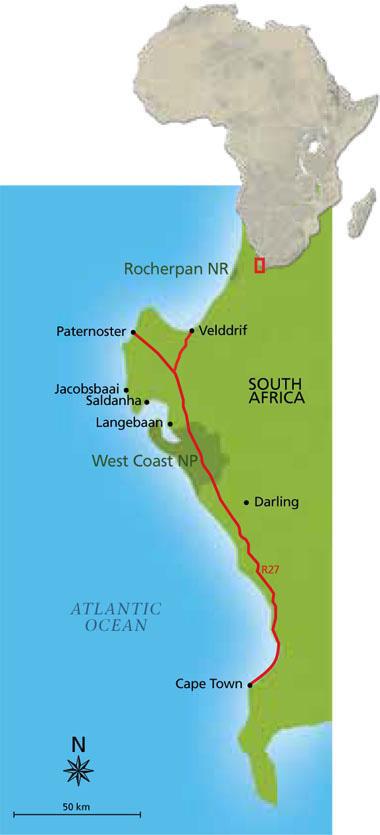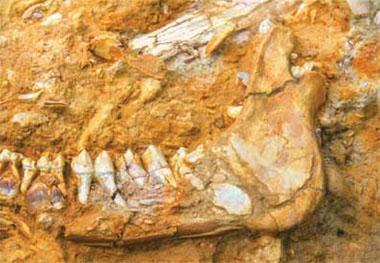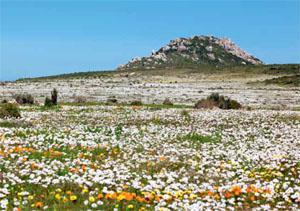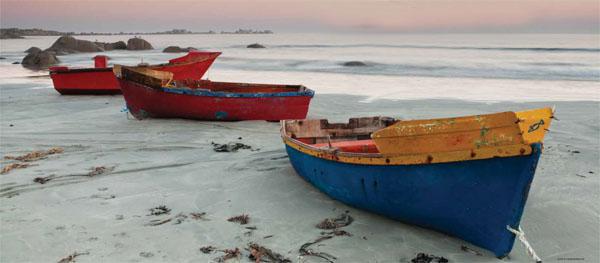Heading into the mild, Wild West
Text and pictures: Peter Borchert. Article from the September 2013 issue of Africa Geographic
Towards the end of the austral winter this year, Peter Borchert and Heila Frieslich took to the R27, heading north from Cape Town on a five-day road trip of the West Coast’s southern circuit.
Well known and equally well loved by locals, this easily accessible region of low dunes, sweeps of dazzling white beaches, coastal fynbos and some pretty good wine estates is often overlooked by visitors from further afield, who tend to venture eastwards if they can bear to tear themselves away at all from the Mother City.
Day 1 Cape Town to Rocherpan
 There are two ‘best times’ to meander around the West Coast: in August and September, when the veld erupts in what is arguably the most spectacular spring wildflower display anywhere in the world; and high summer (December to February), when it can be wiltingly hot and dry, when life beside the sea can render you incapable of anything other than another swim, another braai (barbecue), another siesta and the opening of yet another bottle of chilled sauvignon blanc.
There are two ‘best times’ to meander around the West Coast: in August and September, when the veld erupts in what is arguably the most spectacular spring wildflower display anywhere in the world; and high summer (December to February), when it can be wiltingly hot and dry, when life beside the sea can render you incapable of anything other than another swim, another braai (barbecue), another siesta and the opening of yet another bottle of chilled sauvignon blanc.
Winter visits can be equally seductive, however, when the surf is exchanged for long beach walks, evening log fires, a lovely soft light and landscapes of gentle greens. It was on one of these mellow winter days that we headed north to the farthest point of our journey, Rocherpan. ‘It’s pronounced Roshay-pan,’ I was told by Ryk Melck, paterfamilias of the widespread Melck clan who have farmed in the region for almost the entire period of European settlement in South Africa. ‘The Rocher family, you see, are of French stock and are insistent on preserving their Gallic heritage.’
You are never too far from the sea as you follow the R27 northwards through gently undulating farmland. Even at a leisurely pace, the 170-odd-kilometre drive from Cape Town to Rocherpan passes in under two hours.
‘Hi there,’ came the cheery greeting from Wynona Didloft, CapeNature’s enthusiastic tourism liaison officer at the reserve. ‘Welcome to Rocherpan.’ She gave us a quick resume of the reserve and our accommodation, matter of factly explaining the procedure for using the waterless loos. ‘Oh no!’ I hear you cry, but don’t worry, these modern facilities are pretty well odourless and a far remove from the ghastly, noisome long-drops many of us have experienced.
 The four eco-chalets on the reserve really are superb and CapeNature is justly proud of them. Open plan, with well-appointed little kitchens stocked with quality equipment, these simple, unobtrusive dwellings have unobstructed views over the pan towards the not-too-distant dunes. They sleep four, but you would need to be very good friends or a single family as there is only one double bed and a sleeper couch. Two-bedroom units are on the way, we were told.
The four eco-chalets on the reserve really are superb and CapeNature is justly proud of them. Open plan, with well-appointed little kitchens stocked with quality equipment, these simple, unobtrusive dwellings have unobstructed views over the pan towards the not-too-distant dunes. They sleep four, but you would need to be very good friends or a single family as there is only one double bed and a sleeper couch. Two-bedroom units are on the way, we were told.
By the time we had settled in it was late afternoon, so we took a drive along the soft, winding reserve track to the top of the furthest dune. A cold breeze had worked itself up by the time we got there so, despite the splendid views of endless beach to the north and south, it wasn’t long before we headed back to the warmth of a log fire and few well-earned glasses of local red.
Good fish, bad fish
It is only natural that visitors to South Africa’s West Coast would want to order seafood in restaurants or to buy it to cook over the coals. However, many of our marine species are under threat from over- exploitation, so always check that your choice is ‘green’. To make sure, sms the name of the fish to the Southern African Sustainable Seafood Initiative, better known as SASSI, on +27 (0)79 499 8795 and you will receive relevant information about your choice. Find out more.
Day 2 Velddrif and a bit of birdwatching
 In the early morning the reserve had disappeared behind a thick grey mist. These coastal fogs are commonplace along the West Coast and in summer they can bring blessed relief from the heat. Occasionally they persist but usually burn off by mid-morning, so in anticipation we decided to backtrack for a quick visit to Velddrif. The town is situated some two kilometres upstream from the mouth of the Berg River. The Afrikaans word drif means ford and this is where early farmers swam their livestock across the river to graze on the far bank. A pont was built at the end of the 1800s and, until the road bridge was built much later, this was the only crossing on offer.
In the early morning the reserve had disappeared behind a thick grey mist. These coastal fogs are commonplace along the West Coast and in summer they can bring blessed relief from the heat. Occasionally they persist but usually burn off by mid-morning, so in anticipation we decided to backtrack for a quick visit to Velddrif. The town is situated some two kilometres upstream from the mouth of the Berg River. The Afrikaans word drif means ford and this is where early farmers swam their livestock across the river to graze on the far bank. A pont was built at the end of the 1800s and, until the road bridge was built much later, this was the only crossing on offer.
In its heyday, Velddrif was an important harbour town where wheat farmers brought their harvests to be loaded onto lighters that ferried them across to larger coasters waiting out in the bay. The dock area was rather prosaically named Laaiplek (the loading place).
 Some parts of Velddrif are downright ugly, but others have that quaint, rather forlorn charm you find in many of the region’s towns. It is well worth exploring though, and keep an eye out for the humour behind many shopfront billboards. My favourite read: ‘Besigheids ure: Saterdag 9:00 … Sondag 10:00 … tot GATVOL’ (Business hours: Saturday 9:00 … Sunday 10:00 until FED UP). Gatvol literally means ‘the hole is full’ in that wonderfully earthy – and essentially untranslatable – idiom of the Afrikaans language.
Some parts of Velddrif are downright ugly, but others have that quaint, rather forlorn charm you find in many of the region’s towns. It is well worth exploring though, and keep an eye out for the humour behind many shopfront billboards. My favourite read: ‘Besigheids ure: Saterdag 9:00 … Sondag 10:00 … tot GATVOL’ (Business hours: Saturday 9:00 … Sunday 10:00 until FED UP). Gatvol literally means ‘the hole is full’ in that wonderfully earthy – and essentially untranslatable – idiom of the Afrikaans language.
As we were in a fishing town it seemed reasonable to go in search of some fresh fish for supper. In a sad commentary on the state of the West Coast fisheries, we were told that there was no such thing in Velddrif; it is all frozen. Nevertheless, when we saw a shop advertising fresh fish, we had to enquire within. The conversation went something like this:
‘Do you really have fresh fish?’ ‘All our fish is fresh,’ came the confident response.
‘Really fresh?’ we challenged. ‘Yes, really fresh.’ ‘ Not frozen?’ we questioned. ‘It’s really fresh … [slight hesitation] Only at this moment it happens to be frozen.
Hot tip: The best way to make sure that your kreef (lobster) is really fresh is to find out when the fishermen return with their hauls and to buy it straight from the boats.
‘Fish-less but chuckling, we headed back to Rocherpan through some of the recent and mostly charmless holiday home developments choking the coast at an alarming rate. First prize for awfulness must go to an estate called ‘Op ‘n Slakke Pas’ (at a snail’s pace) where the chalets echo the curved architecture of snail shells.
 Rocherpan Nature Reserve, which focuses on the vlei (a shallow seasonal lake), was established in 1967 and includes the dunes that separate it from the beach and the adjacent marine area, which achieved protected status in 1988. The history of the place reaches back to 1839, however, when then-landowner Pierre Rocher blocked the mouth of a small river, forcing the waters to debouch into the low flat area behind the dunes. His actions, designed to provide water for his livestock, would have destroyed the natural ecology of the river, but inadvertently created a perfect haven of reeds and shallows for a host of waterbirds.
Rocherpan Nature Reserve, which focuses on the vlei (a shallow seasonal lake), was established in 1967 and includes the dunes that separate it from the beach and the adjacent marine area, which achieved protected status in 1988. The history of the place reaches back to 1839, however, when then-landowner Pierre Rocher blocked the mouth of a small river, forcing the waters to debouch into the low flat area behind the dunes. His actions, designed to provide water for his livestock, would have destroyed the natural ecology of the river, but inadvertently created a perfect haven of reeds and shallows for a host of waterbirds.
Regrettably, we didn’t have enough time to explore much of the nature trail that, complete with sturdy boardwalks, rings the vlei and brings you full circle via a hike along the seashore. But we did visit the well-positioned bird hides, where we watched the passing parade of flamingos, oyster-catchers and many other water and shore birds. All in all, the birdlist for the reserve tops the 200-species mark.
Day 3 The road to Langebaan
I would have happily spent more days at Rocherpan, but we had to move on to Langebaan, via Paternoster and Jacobsbaai. On your first visit to Paternoster, don’t be alarmed when a snag-toothed grin in the middle of a deeply salt-and-sun-lined face appears at your car window accompanied by two equally weathered hands making strange quotation mark gestures. He (the mime is invariably a man) is just using local sign language to let you know he has live kreef or rock lobsters for sale. This delicacy, one of the few seasonal mainstays of the local economy, can be bought for a fraction of the ridiculously high prices you will pay in a restaurant. So, if you are up to the cleaning and cooking bit, inexpensive fine dining is at hand.
 Paternoster is a charming place that, although also flirting with the dangers of overdevelopment, has at least maintained some semblance of architectural integrity, and it deserves at least a two-night stay. Over the years I have been privileged to spend time during midsummer at one of its sprawling beach houses, which are available to rent through any number of holiday rental agencies. What a pleasure to park your car in the garage on your arrival, and know that you probably won’t need it until you leave.
Paternoster is a charming place that, although also flirting with the dangers of overdevelopment, has at least maintained some semblance of architectural integrity, and it deserves at least a two-night stay. Over the years I have been privileged to spend time during midsummer at one of its sprawling beach houses, which are available to rent through any number of holiday rental agencies. What a pleasure to park your car in the garage on your arrival, and know that you probably won’t need it until you leave.
Hot tip: When hiring a house in Paternoster, make sure you get one with uninterrupted sea views. Rental agents can be economical with the truth and you don’t want to end up where the only glimpse of the ocean is through an upstairs bathroom window while standing on a chair.
Restaurants abound, but if you are there in the holiday season (and this applies anywhere along the West Coast) be sure to book your table well in advance. Our favourite places are Voorstrandt, right in the middle of the main sweep of the beach, The Noisy Oyster in town and Gaaitjie, a tiny, eccentrically decorated eatery also on the beach, where the equally eccentric and somewhat intimidating owner invents some of the most delicious dishes you are likely to have anywhere.
Adjacent Tittiesbaai (so named because of two vaguely breast-shaped rocky outcrops) is worth a visit but I wouldn’t stay there. At the risk of displaying extreme prejudice, I see no pleasure in cheek-by-jowl camping where in summer you are either sweating under canvas or trying to prevent your tent from soaring out to sea on a southeast gale.
 Although the wind can be a real spoiler of fun anywhere along the West Coast, there wasn’t a breath as we entered the little settlement of Jacobsbaai, which clings to the rocks around a couple of picturesque coves. The social focus of Jacobsbaai is Weskusplek, a restaurant and accommodation complex right on the water’s edge. We had the place almost to ourselves for a pleasant midweek lunch, but come the weekend it’s time for a real opskop and the place is packed to the rafters with carousing partygoers – not surprising when you learn that one of the owners is popular Afrikaans singer Steve Hofmeyr.
Although the wind can be a real spoiler of fun anywhere along the West Coast, there wasn’t a breath as we entered the little settlement of Jacobsbaai, which clings to the rocks around a couple of picturesque coves. The social focus of Jacobsbaai is Weskusplek, a restaurant and accommodation complex right on the water’s edge. We had the place almost to ourselves for a pleasant midweek lunch, but come the weekend it’s time for a real opskop and the place is packed to the rafters with carousing partygoers – not surprising when you learn that one of the owners is popular Afrikaans singer Steve Hofmeyr.
Another short hop and we were in Langebaan, having skirted the deep-sea harbour and military base of Saldanha Bay. In sharp contrast to the tucked-away feeling you get in the likes of Paternoster and Jacobsbaai, Langebaan has all the hustle and bustle of the sizeable town that it is. Supermarkets abound, as do fast-food outlets. Although this might be seen to detract, it is these very conveniences coupled with its proximity to Cape Town (about an hour away) that make Langebaan the holiday mecca that it is.
Footprints and fossils
 If you stand atop a windswept dune and feel a primal connection to the landscape, don’t be too surprised. Our association with this region stretches back 117 000 years to the oldest known footprint of a modern human. The fossil, called Eve’s Footprint, now resides at Cape Town’s Iziko Museum, but you can see a replica at the West Coast National Park’s information centre. You can also follow Eve’s Trail, a fully portered two-and-a-half day hike.
If you stand atop a windswept dune and feel a primal connection to the landscape, don’t be too surprised. Our association with this region stretches back 117 000 years to the oldest known footprint of a modern human. The fossil, called Eve’s Footprint, now resides at Cape Town’s Iziko Museum, but you can see a replica at the West Coast National Park’s information centre. You can also follow Eve’s Trail, a fully portered two-and-a-half day hike.
Indulge your passion for prehistory further at the West Coast Fossil Park. Here the five-million-year-old remains of 200 species have been unearthed, including sabre-tooth cats, short-necked giraffes and Africa’s only known bear. Activities include biking, hiking, horseriding and even hunting for your own fossils.
Recreational life here revolves around the lagoon, where safe waters and reliable sunshine draw a constant flow of kite- and windsurfers, kayakers, yachtsmen, waterskiers and fishermen. Golfers are  well provided for and if you fancy a flutter at the casino, Club Mykonos is just around the corner. But, if you want peace and quiet and a chance to get stuck into that book you’ve brought, you can find that too.
well provided for and if you fancy a flutter at the casino, Club Mykonos is just around the corner. But, if you want peace and quiet and a chance to get stuck into that book you’ve brought, you can find that too.
We sought sanctuary at Greystones Beach House, which fronts onto the lagoon and is hidden from the road by sturdy, wind-deflecting milkwood trees. Beautifully appointed and elegant without being intimidating, it really is lovely, made all the more so by the meticulous attentions of major-domo Boston Munthali.
Day 4 Exploring the West Coast National Park
 Langebaan Lagoon is a tidal wetland of international importance for migratory birds and a host of resident species. The world’s largest breeding colony of black harriers, for instance, also occurs in the area. The entire southern and eastern shores of the lagoon form part of the West Coast National Park, which is easily accessible from Langebaan town, and from the R27 heading north from Cape Town. The park is enticing not only for the birdlife, but also for the stunning views it offers across the lagoon as well as the Atlantic Ocean that bashes away along the length of the eastern peninsula.
Langebaan Lagoon is a tidal wetland of international importance for migratory birds and a host of resident species. The world’s largest breeding colony of black harriers, for instance, also occurs in the area. The entire southern and eastern shores of the lagoon form part of the West Coast National Park, which is easily accessible from Langebaan town, and from the R27 heading north from Cape Town. The park is enticing not only for the birdlife, but also for the stunning views it offers across the lagoon as well as the Atlantic Ocean that bashes away along the length of the eastern peninsula.
There are some good lookout points for whale watching, and you may also be lucky enough to see one the larger land mammals, such as eland, wildebeest, hartebeest, bontebok, springbok, kudu and mountain zebra. Watch out too for tortoises, porcupines and dune mole-rats, chunky rodents that frequently venture above ground. We were happy to stop for a mole-rat specimen the size of a small cat as it nonchalantly crossed the road.
 Hot tip: The West Coast National Park is at its colourful best in August and September when the spring flowers are mind-bobbling, especially in the Postberg section, which is only open to the public during these two months.
Hot tip: The West Coast National Park is at its colourful best in August and September when the spring flowers are mind-bobbling, especially in the Postberg section, which is only open to the public during these two months.
Day 5 Hello Darling and back to Cape Town
Just before the southern entrance to the West Coast National Park, take the R315 off the R27 and, within an hour from Langebaan, you will find yourself on the other side of the world. I am not a great lover of website publicity blurbs but I can’t resist this extract from the Darling Tourism site: ‘Darling is the heartbeat of the West Coast region. The little village lies tucked away between hills of vineyards and golden wheat fields. Here you can still expect to see a horseman cantering through the streets on a Saturday afternoon… You may witness a funeral procession accompanied by the consolatory gospel sounds of a traditional brass band. Lovingly restored Victorian homes and ancient trees make an idyllic setting for a getaway that promises serenity, nature, culture and much more!’
It really is just like that and the only aspect I would add to the town’s mix of eccentricities is what I can only describe as a mickey-taking sense of humour. Perhaps it derives from Darling’s most famous darling, Pieter-Dirk Uys, South Africa’s beloved satirist who, playing himself and his creation Evita Bezuidenhout, has mercilessly lampooned just about every prominent politician and celebrity in the country, past and present. Uys owns Darling’s defunct railway station and here at Evita se Perron (perron is Afrikaans for platform), he has created a restaurant theatre as much for his own amusement, I suspect, as for visitors who make the pilgrimage. Not to be missed.
If you feel the need, as we did, to delay re-entry into the city until the last possible moment, pop into one of the many wine estates in the vicinity of Darling. Two of my favourites are Groote Post and Cloof, which also plays host to the annual ‘Rocking the Daisies’ music festival.
See Peter Borchert’s ‘West Coast holiday planner’ for more useful information and contacts at blog.africageographic.com
| More info on the City of Cape Town | More info on the West coast area |
Book your accommodation right here on ShowMe.
You can find the top hotels, lodges and Airbnb establishments conveniently placed on the map below. All you need to do is click on the place that’s conveniently located and within your budget and then make a booking. What could be easier?
If the map is not where you want to be, click on the ShowMe Pin and then enter the exact name of the location and the map will adjust accordingly.








